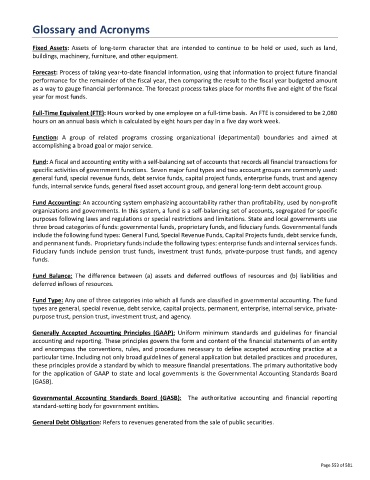Page 553 - FortWorthFY22AdoptedBudget
P. 553
Glossary and Acronyms
Fixed Assets: Assets of long-term character that are intended to continue to be held or used, such as land,
buildings, machinery, furniture, and other equipment.
Forecast: Process of taking year-to-date financial information, using that information to project future financial
performance for the remainder of the fiscal year, then comparing the result to the fiscal year budgeted amount
as a way to gauge financial performance. The forecast process takes place for months five and eight of the fiscal
year for most funds.
Full-Time Equivalent (FTE): Hours worked by one employee on a full-time basis. An FTE is considered to be 2,080
hours on an annual basis which is calculated by eight hours per day in a five day work week.
Function: A group of related programs crossing organizational (departmental) boundaries and aimed at
accomplishing a broad goal or major service.
Fund: A fiscal and accounting entity with a self-balancing set of accounts that records all financial transactions for
specific activities of government functions. Seven major fund types and two account groups are commonly used:
general fund, special revenue funds, debt service funds, capital project funds, enterprise funds, trust and agency
funds, internal service funds, general fixed asset account group, and general long-term debt account group.
Fund Accounting: An accounting system emphasizing accountability rather than profitability, used by non-profit
organizations and governments. In this system, a fund is a self-balancing set of accounts, segregated for specific
purposes following laws and regulations or special restrictions and limitations. State and local governments use
three broad categories of funds: governmental funds, proprietary funds, and fiduciary funds. Governmental funds
include the following fund types: General Fund, Special Revenue Funds, Capital Projects funds, debt service funds,
and permanent funds. Proprietary funds include the following types: enterprise funds and internal services funds.
Fiduciary funds include pension trust funds, investment trust funds, private-purpose trust funds, and agency
funds.
Fund Balance: The difference between (a) assets and deferred outflows of resources and (b) liabilities and
deferred inflows of resources.
Fund Type: Any one of three categories into which all funds are classified in governmental accounting. The fund
types are general, special revenue, debt service, capital projects, permanent, enterprise, internal service, private-
purpose trust, pension trust, investment trust, and agency.
Generally Accepted Accounting Principles (GAAP): Uniform minimum standards and guidelines for financial
accounting and reporting. These principles govern the form and content of the financial statements of an entity
and encompass the conventions, rules, and procedures necessary to define accepted accounting practice at a
particular time. Including not only broad guidelines of general application but detailed practices and procedures,
these principles provide a standard by which to measure financial presentations. The primary authoritative body
for the application of GAAP to state and local governments is the Governmental Accounting Standards Board
(GASB).
Governmental Accounting Standards Board (GASB): The authoritative accounting and financial reporting
standard-setting body for government entities.
General Debt Obligation: Refers to revenues generated from the sale of public securities.
Page 553 of 581

